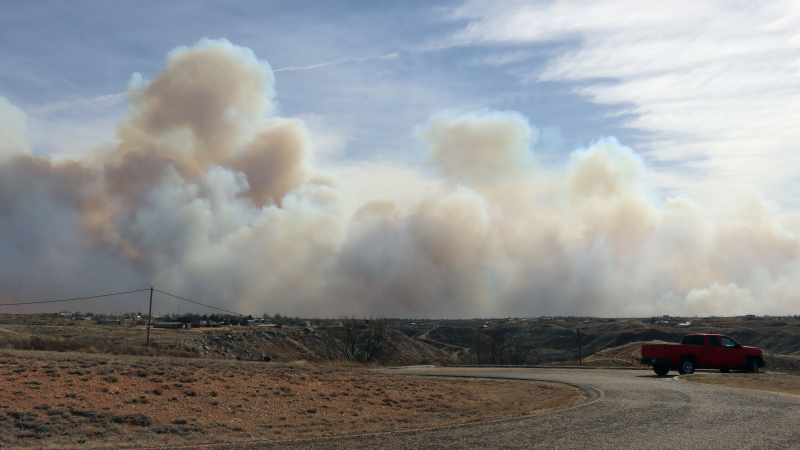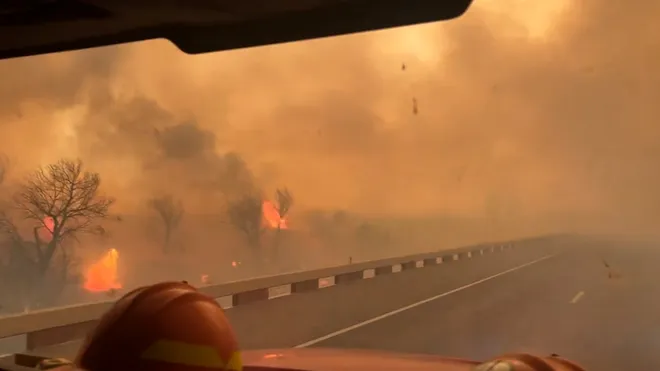USA is littered with nuclear sites that could face danger from natural disasters
Massive wildfires in Texas caused operations at the nation's primary nuclear weapons facility to be paused earlier this week, another reminder that the United States is covered in highly sensitive locations that house nuclear weapons, waste and energy reactors.
The U.S. has more than 3,700 nuclear warheads stockpiled around the country and 54 nuclear power plants in 28 states. And while nuclear energy facilities and weapons sites have always been built with potential natural disasters in mind — whether it was earthquakes, hurricanes, tornadoes or floods — those disasters stress their support systems and create new worries for safety experts.
As of Wednesday evening, the Pantex nuclear weapons plant near Amarillo was not harmed and safely reopened.
Experts told USA TODAY that natural disasters like Texas' wildfires typically don't create an immediate nuclear threat, but they do make carefully caring for nuclear materials more expensive and difficult, increasing safety worries over the long term. Those worries are only compounded by disasters that keep getting worse as the planet warms.
Good news: Nuclear weapons remain well-protected
When it comes to stored nuclear warheads, the weapons themselves are relatively well-insulated and protected. There’s little concern that a wildfire would cause them to detonate or a flood or heat event somehow set them off.
“These warheads are stored underground in highly secure facilities," said Jamie Kwong, a fellow at the nuclear policy program at the Carnegie Endowment for International Peace.

For nuclear power plants, the Nuclear Regulatory Commission requires extensive preparedness and planning for possible disasters. Nuclear power plants are already extremely hardened industrial sites and the agency notes there have been no injuries or fatalities to the U.S. public from exposure to radiation.
However, an analysis of the risks at nuclear power plants done in 2020 by business research and risk firm Moody's found that costs are likely to increase due to the need to increase protections in a changing climate. That's in part because nuclear power plants use external water sources for cooling, so most are built near rivers, lakes and oceans, putting them at greater risk of flooding, storm surges and sea level rise.
Bad news: Disasters can still affect other aspects of nuclear safety
While outright destruction is not considered a threat, a concern is that weather events could disrupt operations at a weapons complex or an energy facility. That could either impede regular or emergency maintenance.
For nuclear power plants, the danger is often to cooling systems. In addition to the infamous 2011 Fukushima nuclear disaster caused by an earthquake and tsunami in Japan, there have been other less dramatic incidents in the U.S.:

- In 2012 Superstorm Sandy hit the eastern U.S., which contained 34 nuclear power plants. High water levels at the cooling intake structure of the Oyster Creek plant in New Jersey put it on alert for almost 48 hours.
- During the 2014 Polar Vortex, unprecedented cold caused FirstEnergy Nuclear Operating Co.’s Beaver Valley 1 in Pennsylvania to shut down due to a transformer failure related to the severe low temperatures. Nebraska’s Fort Calhoun Station also temporarily shut down when ice impaired the operation of one of its water intake gates.
- At North Dakota's Minot Air Force Base, increasingly warm temperatures raise the risk of flooding that in turn could impact accessibility to intercontinental ballistic missile silos and facilities critical to U.S. nuclear deterrence plans. Flooding there in 2011 caused the base to experience significant disruption.
Climate change is fueling disasters, increasing concerns
Experts say the Texas wildfires highlighted the dangers natural disasters could pose to America's widespread nuclear weapons and energy networks. Eleven states are home to nuclear weapons, 28 to nuclear power plants and spent nuclear fuel storage.
In Texas, the fire's flames were spread by strong winds, dry conditions and unseasonably high temperatures, which broke records across the country — just the kind of conditions that experts have long warned are more likely as Earth warms.
“We need more attention on the nexus of climate and nuclear,” said Kwong.
Climate change effects have already caused nuclear concerns around the world: "Places like North Korea and Pakistan are already facing these threats," said Kwong.
North Korea has experienced increases in typhoons, droughts and flooding, according to the Royal United Services Institute, a United Kingdom-based defense think tank.
In 2022, massive flooding covered more than one-third of the nation of Pakistan, affecting more than 33 million people.
Disclaimer: The copyright of this article belongs to the original author. Reposting this article is solely for the purpose of information dissemination and does not constitute any investment advice. If there is any infringement, please contact us immediately. We will make corrections or deletions as necessary. Thank you.






